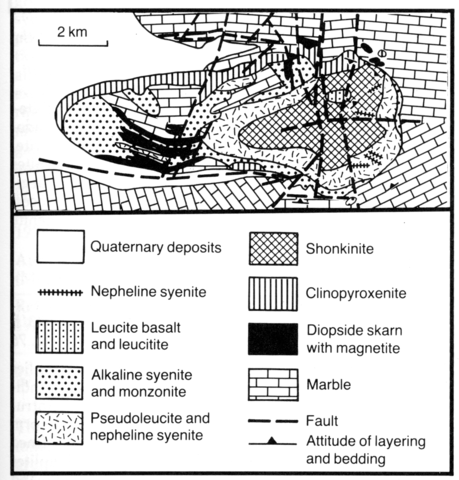stripes
Irisu is an intrusion of assymetrical form which is concentrically zoned and emplaced into limestones. The area is more than 25 km2 (9x3 km), but only the more easterly 8 km2 outcrops at the surface. It has a complicated structure being composed of subvolcanic stocks and ring intrusions that change from the periphery to the centre. Three stages have been distinguished the rocks of which comprise, from youngest to oldest: (1) leucite basalts and leucitite necks; (2) a subvolcanic stage including nepheline porphyry, shonkinite porphyry and phonolite; (3) a plutonic stage consisting of koswite (olivine clinopyroxenite), leucite and orthoclase pyroxenite (first phase), monzonite, shonkinite, melanite alkaline syenites (second phase), pyroxene-biotite syenite, nepheline syenite, fergusite (third phase) and syenite porphyry (fourth phase). Detailed investigations of the structure of the Irisu massif confirm that all the alkaline rocks can be related to up to three intrusive centres, that appear to be centred about the stock of leucite basalts. The most widely distributed rocks in the complex are pseudoleucite syenite, fergusite, pseudoleucite porphyry and pseudoleucite pyroxenite which are composed of feldspar-zeolite, feldspar-analcime and feldspar-liebenerite, aggregates of psuedo- and epileucite, K-feldspar, pyroxene (diopside, diopside-augite and augite), biotite (lepidomelane), amphibole, nepheline and plagioclase. The accessories are magnetite, apatite, titanite, melanite and fluorite. K-feldspathisation is well developed, especially along fissure zones, in which primary rocks may be feldspathised to the composition of syenites, while the development of biotite is also typical in Irisu rocks.
NURLIBAYEV, A.N. 1973. Alkaline rocks of Kazakhstan and their ore deposits. Nauka, Alma-Ata. 296 pp.
NURLIBAYEV, A.N. 1976. Magmatism of north Kazakhstan. Akademii Nauk Kazakhstan SSR, Alma-Ata. 249 pp.
ORLOVA, M.P. 1959. Alkaline gabbroid intrusions of the north-west part of the Tholoss Alatau Range. Scientific Note, Leningrad University, Geology Series, 291: 91-121.

